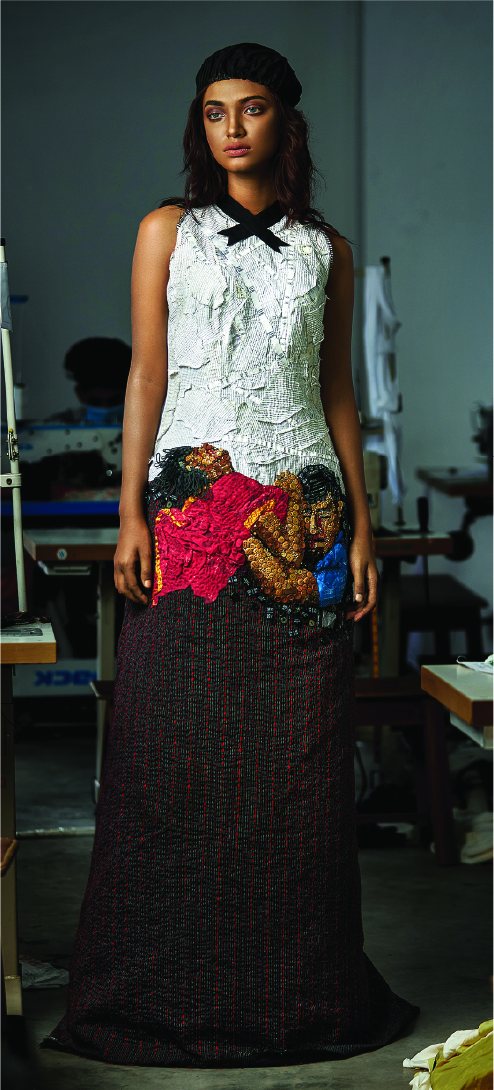DESIGNER OF ‘HERSTORY’ BY AARONG, SAMIUL ALAM, SHEDS LIGHT ON HIS NEW SOLO COLLECTION AT IFA PARIS, ‘BLOOD, SWEAT & TEARS’ AND AND SHARES HIS VIEW ON THE FASHION INDUSTRY.

Designer
‘Herstory’ by Aarong
How did it occur to you that your artistic side is best expressed through fashion? What does fashion mean to you?
Well, it’s an interesting question because I actually express my artistic side through other mediums like painting, music and creative writing. I have chosen fashion designing as a profession because it ties my other interests together and, in a sense, allows me to challenge myself more. There’s a thrill to fashion: the silhouettes, colours, textures, movements and the everlasting thirst for creation.
For me, fashion is a language that allows me to speak without words, explore without a voyage, fly without wings and communicate without a device. It’s the universe where I find my salvation.

What message are you trying to convey through your fashion collection, ‘Blood, Sweat, & Tears’?
The phrase ‘Blood, Sweat & Tears’ literally means extreme hard work. The concept behind this fashion collection is ‘showing the fashion industry through the perception of garment factory workers.’ To the rest of the world, fashion is stereotypically portrayed as glamour, luxury and the high life, but I wanted to show the other side of the coin from the point of view and experience of the people who make our clothes. As we speak, fashion is either liberating a group of people or it’s caging certain communities, and that is a bigger question for humanity. This is a fully up-cycled collection made with used denim pants, recycled sarees, end of the roll fabrics, and factory waste trims and accessories. The objective is to remember our past, face the reality and create an ethical working environment for the people working for the clothing supply chain.
THERE’S A THRILL TO FASHION: THE SILHOUETTES, COLOURS, TEXTURES, MOVEMENTS AND THE EVERLASTING THIRST FOR CREATION.
The exhibition has ‘acts.’ Could you elaborate on this concept and what story each act is telling?
Every story has acts, but not necessarily is it always practised in the fashion collection creation. My collection uses fashion as a language of reflection; I created acts to craft the flow of the story. The collection has three acts: Confrontation, Tragedy and Aftermath. ‘Confrontation’ evokes the acuity of the factory workers. The opening look is an outfit with the slogan ‘We make your clothes’. Gradually the rest of the designs depict their hard work, long working hours, injuries & work environment related sufferings. It trails chronologically to the second act, ‘Tragedy,’ which recollects the dreadful memories of the Tazreen factory fire in 2012 and the Rana Plaza disaster in 2013 to imply the price they paid for fashion. In this act, I tried to portray the post-catastrophic visuals in the clothes as a symbolic interpretation of the reality behind what we wear. This brings the collection to the last act, ‘Aftermath,’ to convey what our factory workers have to say, and it concludes with the message “No More Death for Fashion.”

What’s your stance on the notion that fashion in our country is very concentrated among a specific social class in the city? How can we democratise fashion among the masses in Bangladesh?
I would somewhat disagree with that because fashion has always been a reflection of society and is directly influenced by the culture, climate, religion, economic situation and norms of the place and the people. It’s true that a specific class plays the role of trendsetters – like celebrities and influencers – but then, another class of people adopts it and it gradually grows into the mass market. It’s the general order of the fashion cycle everywhere. In Bangladesh, I think everyone does fashion according to their taste, knowledge and economic situation, just like anywhere else in the world. The choice of the adaptation of fashion is still limited because of our cultural norms. We still need to answer to the society for our clothing which means we have to follow a general guideline for wearing clothes rather than being individualistic about it. I believe we are in the beginning stages of a social change in Bangladesh, where the wheel is gradually spinning towards an individualistic, diverse and open-minded ideology. I believe, within the next 10 years, Bangladesh will be a lot more liberated in terms of fashion and lifestyle.
I BELIEVE WE ARE IN THE BEGINNING STAGES OF A SOCIAL CHANGE IN BANGLADESH, WHERE THE WHEEL IS GRADUALLY SPINNING TOWARDS AN INDIVIDUALISTIC, DIVERSE AND OPEN-MINDED IDEOLOGY. I BELIEVE, WITHIN THE NEXT 10 YEARS, BANGLADESH WILL BE A LOT MORE LIBERATED IN TERMS OF FASHION AND LIFESTYLE.
What other projects are you currently involved in? What can we expect to see from you in the future?
I just had a solo exhibition of my collection ‘Blood, Sweat & Tears’ in Paris. It was organised by Fashion Revolution and partnered by IFA Paris. Right now, I’m finishing the last semester of my Masters and preparing for the Paris Fashion Graduation show set for 8 July 2022. Upon completion, I’ll return to Bangladesh and rejoin ‘Herstory’ by Aarong. Meanwhile, I’m working as the costume designer for ‘Project Ommi,’ the first sci-fi film from Bangladesh.
Bangladesh has a lot of possibilities as we are the 2nd largest garment manufacturer in the world. I would like to work for the betterment of the Bangladesh fashion industry. Therefore, I have decided to spread my international exposure and education to the fashion students and young professionals here as much as I can so that we can grow together as a strong fashion community in the world.
